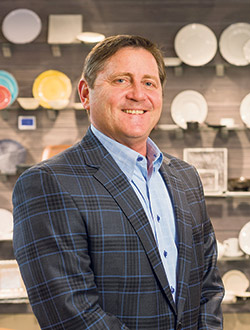Ask five people in foodservice-related occupations to give their predictions for 2020, and you’ll hear five totally different answers (or almost totally different). One concern — finding and keeping good employees — affects every aspect of foodservice, from front-of-the-house service to sales to consulting. With that as a starting point, five foodservice industry leaders share their vision for 2020 and beyond.
A Foodservice Revolution
 Randy SparrowsRandy Sparrow, director of Food and Environmental Services for ProHealth Care in Waukesha, Wis., an operator of hospitals and associated healthcare facilities
Randy SparrowsRandy Sparrow, director of Food and Environmental Services for ProHealth Care in Waukesha, Wis., an operator of hospitals and associated healthcare facilities
Quick Take: A healthcare operator sees a strong movement toward a less protein-centric menu driving change in this sector.
What’s your outlook for the industry in 2020?
With the massive shift in focus toward veggie-centric cuisine and plant-based proteins in lieu of traditional, animal-based proteins, it appears that the foodservice industry as a whole is turning this trend into the new status quo. We are already seeing the major players in meat processing exploring this movement, and issues like African swine fever are making this transition not only easier but basically common sense for those still competing for their market share. With this meatless revolution, we are now seeing better-quality and better-tasting options, both vegetarian and gluten-free.
What’s your biggest concern or worry for the next year? What excites you the most?
Labor is a concern: skilled labor, maintaining current labor and increasing wages for nonskilled labor.
What excites me most: We are at the forefront of a foodservice revolution. Traditional center-of-plate paradigms are being completely overhauled. Classic cuisine has its merits, but the future is moving toward healthy and sustainable food products. We are even more focused on the ethical treatment of animals and ethical food procuring practices. Additionally, the current zeitgeist of hospital food is finally eliminating the stigma of processed, scoop-and-serve food; this will continue and will not regress.
Do you see the types of equipment that you currently use changing in the near future?
Technology is going to be key. New technology is beginning an era in which the [traditional] convection oven will become an endangered species. We’re testing a chambered oven that allows you to cook four separate items at once. It still has convection but allows us more flexibility with our product. It’s newer technology that’s like a godsend to us, allowing us flexibility in our smaller locations.
Robotics is going to be a game changer, but I haven’t convinced my hospital to go with food deliveries by robots. With today’s labor market, I think there is a need to find machinery that’s going to help us.
Complete this thought: In order to be successful in the coming year, our organization will need to …
Continue to evolve and embrace the drastic changes that are at the forefront of the foodservice revolution!
Some Headwinds, but Overall Optimism
 Eric Boelter Eric Boelter, president of The Boelter Companies, a foodservice equipment and supplies dealer and design firm headquartered in Waukesha, Wis.
Eric Boelter Eric Boelter, president of The Boelter Companies, a foodservice equipment and supplies dealer and design firm headquartered in Waukesha, Wis.
Quick Take: Advances in equipment technology will help foodservice operators perform more efficiently in an uncertain environment.
What’s your outlook for the industry in 2020?
This is a difficult question to answer. We see a considerable amount of downward pressure on margins and some headwinds on national accounts. That being said, the pipeline is healthy going into the first quarter of 2020. There is more uncertainty with the future trajectory of the industry than there has been in the past three years. We are also noticing a continued compression of time from when we sign new projects to the time that they install. This makes it more challenging to have a clear view into 2020.
What’s your biggest concern or worry for the next year? What excites you the most?
My biggest concern is that the uncertainty in the geopolitical environment mutes what has been a great economic story in the U.S. We rely on our customers to have a positive future outlook so that there is continued investment in construction and remodels.
I am looking forward to watching continued innovation in how food is made and delivered to end customers. How will foodservice providers align their business around the changing customer preferences? I am also impressed with much of the new technology and cooking equipment innovations. Many of these innovations will be making their way into the market this year and helping our customers do more with fewer pieces of equipment.
What trends have you seen in foodservice equipment that you think are going to have a big effect on the industry?
Multiuse cooking equipment and advances in cooking technology that reduce waste, improve food quality and give the operator increased flexibility. Multicook technology is going to continue to expand, which allows [manufacturers] to shrink the size of ovens. The integration of technology into cooking and refrigeration systems [such as] wireless technology, equipment feedback and HACCP control.
Complete this thought: In order to be successful in the coming year, our
organization will need to …
Adapt to a rapidly changing market — new competitors and changing user preferences. Align our value proposition with the challenges being experienced by our customers and continue to advance with customer-facing technology while simplifying internal processes.
Embracing New Technologies
James Walker, senior vice president of Nathan’s Famous, a 252-unit quick-serve chain James Walker
James Walker
Quick Take: Perhaps more than other segments, technology continues to change
the way quick-serve restaurants operate. But the customer experience remains paramount.
What’s your outlook for the industry in 2020?
I believe the industry is going to see continued difficulties in driving incremental traffic. I think you’ll see increasing demand by consumers for quality, customization and convenience, and a continued push toward things like plant-based proteins and vegan items. You will continue to see brands who innovate and embrace data and technology being rewarded.
What’s your biggest concern or worry for the next year? What excites you the most?
My concern is very simple. It’s the item that’s really keeping me up at night, and that’s labor. The difficulties in providing a truly guest-focused workforce that’s going to take care of our guests is my single biggest concern. It’s what I wrestle with. The technology to make the guest experience better is certainly improving every year. But we’re in a position now where getting that fantastic employee is more and more difficult, and I don’t see it getting any easier.
What excites me most is the increasing pace of innovation within the industry [with] new products and new technology, both back of house as well as consumer-facing.
Do you see the types of equipment you currently use changing in the near future?
A lot of the industry today and a lot of our contemporary brands are looking at equipment to try to displace labor or to help reduce hours. I look to the equipment providers and designers not to help me displace labor but to make my current workforce more efficient.
Complete this thought: In order to be successful in the coming year, our organization will need to …
Embrace five things: change and the pace of change, technology, data (and what a powerful tool it can be to answer consumer demands and needs), their guests, and lastly, their employees. Your brand promise is brought to the guest through your employees, so any brand that doesn’t embrace its workforce is ultimately designed to fail.
Predicting a Banner 2020
Mike McGuire, managing partner of Zink Foodservice, an independent manufacturers’ rep firm based in Mike McGuire Columbus, Ohio
Mike McGuire Columbus, Ohio
Quick Take: A record year could be affected by the labor situation. Labor- and work-saving technology will help ease the labor crunch.
What’s your outlook for the industry in 2020?
We’re planning for 2020 to be a record year. From gigantic dealers all the way to designers and consultants — all are extremely busy putting projects in for 2020. With interest rates continuing to be low, money’s readily available to restaurateurs.
What’s your biggest concern or worry for the next year? What excites you the most?
The labor shortage is a gigantic problem and stretches into every aspect of this business. It affects retailers being able to staff their stores and could potentially curtail expansion of new restaurants or facilities.
But the industry itself has settled down. The consolidation of the industry has slowed slightly, which means it’s more of a normal business process than in the last several years, where there have been many acquisitions and consolidations. 2020 will be more ‘business as usual’ than we’ve seen over the last few years.
Do you think technology will continue to affect all types of equipment?
Yes; with technology, everything’s smarter, faster and smaller. For example, one item that’s really interesting is an oil measuring tool that measures the oil quality inside fryers. It automatically tells you when oil is degraded, or you need to filter it or discard it. It saves labor for the operator, who doesn’t have to be involved in testing the oil.
Or now there are simple, inexpensive tools that allow operators to clean filters and ductwork [as compared with] very expensive UV hoods or bringing in third-party companies to clean for you. It’s quite a savings.
Complete this thought: In order to be successful in the coming year, our organization will need to …
Attract top talent and develop their abilities. Our customers need information faster than ever before. As reps, we’re really information expediters. If we’re good at that, we’re good at taking care of our customers. As we continue to develop our processes here to get better at serving our customers, we’re going to be successful.
A Team-Focused Approach
Nahum Goldberg, FCSI, LEED AP, principal of NGAssociates Foodservice Consultants, a foodservice  Nahum Goldbergdesign and operations consulting firm based in El Cerrito, Calif.
Nahum Goldbergdesign and operations consulting firm based in El Cerrito, Calif.
Quick Take: One designer/consultant notes that uncertain political and economic issues make it challenging to predict business in 2020.
What’s your outlook for the industry in 2020?
It’s been very good for the last couple of years. Everyone is a little bit careful about predicting a long, strong continuation of the same but hoping for it. This ties into political and economic issues that are a little bit up in the air. The economy runs in cycles, so I think it’s a good time to appreciate what we have and diversify as much as possible, which we are. We’re working in all different sectors — higher education, some government projects — because they usually run on a little different cycle from corporate, which is one of our strong areas.
What’s your biggest concern or worry for the next year? What excites you the most?
My worry — and [that of] a lot of others in the industry as well — is a dramatic change in the economic system that would impact decisions to do projects. Alongside that, my attention is always on our team, making sure our goals are aligned as a team and retaining the great team members that we have. It’s a very competitive market right now, especially in our industry.
The exciting things are watching new trends in meal delivery and newer models coming into workplace dining, like open kitchens and action stations.
What are the biggest trends you see affecting the equipment side of the industry?
Ventless equipment is definitely increasing in prevalence and acceptance. There are more solutions coming out for ventless cooking applications with the benefits [of] less infrastructure or exhaust ventilation, allowing food to be brought to areas where the ventilation requirements were difficult to meet.
Ordering systems for cashless is definitely a trend. I think the cash checkout system is probably a thing of the past. That is rapidly moving away from large hardware, like a kiosk, and onto your smartphone.
The all-electric kitchen is definitely a trend. Some local jurisdictions are starting to legislate in that area and the whole idea is to be better able to support renewable energy sources, and create increased energy efficiency.
Complete this thought: In order to be successful in the coming year, our organization will need to …
Stay focused on the team. Improve process and efficiency for what we do. Keep abreast of creative aspects in the industry and communicate well with our clients.




